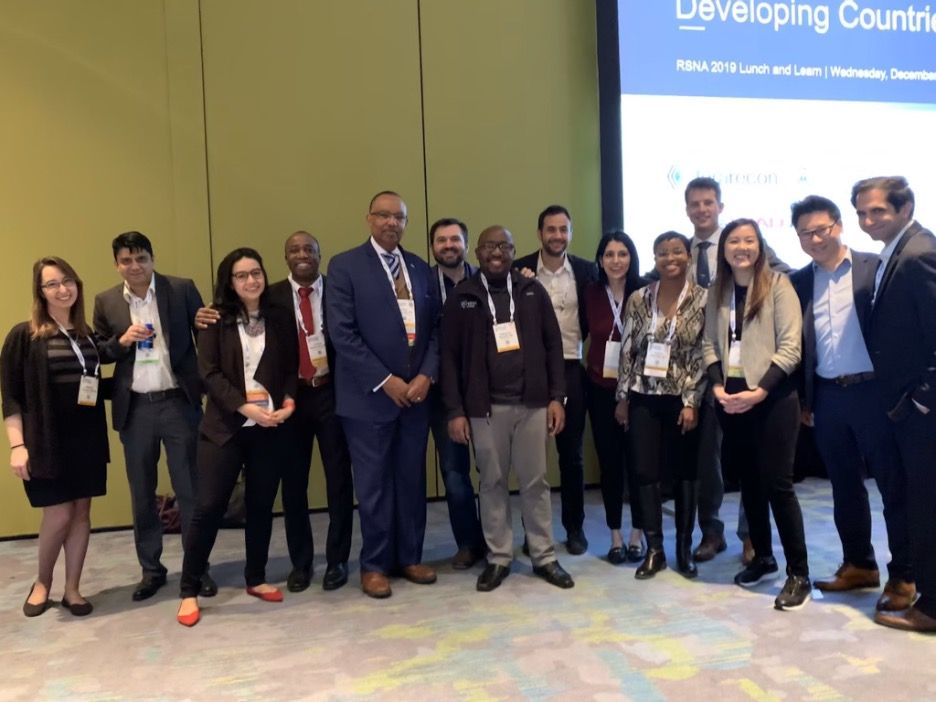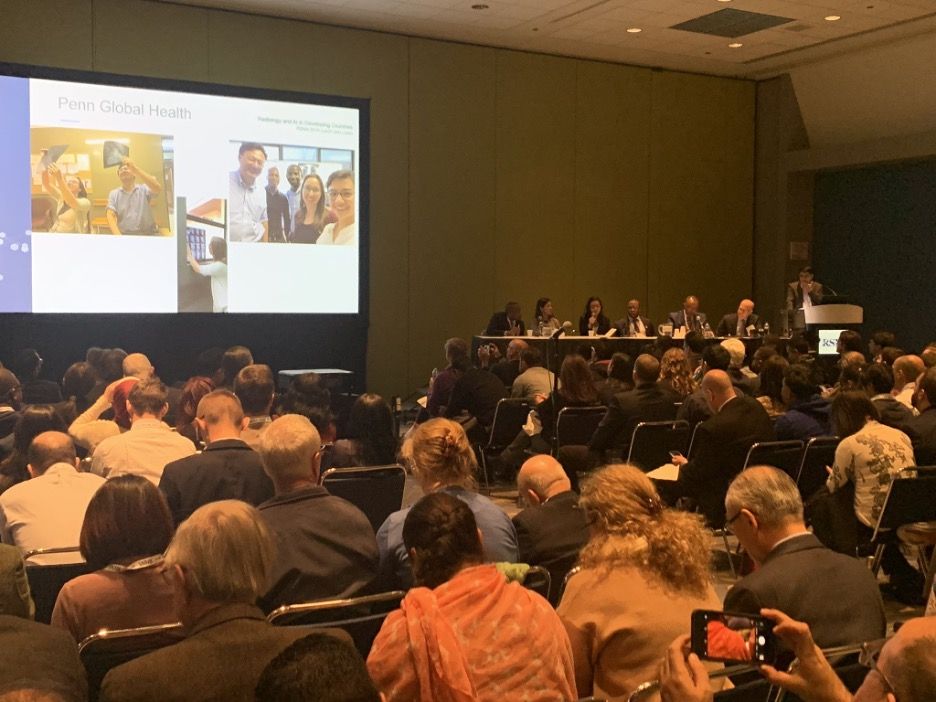Radiology and AI for the Developing World
Penn Medicine is dedicated to improving artificial intelligence to address radiology needs in individual institutions worldwide, both improving performance and patient outcomes.
Diagnostic imaging powers the heart of every hospital. The presence of medical imaging resources has a tremendous impact on the quality of care patients receive, and, unfortunately, the deficiency of these resources can have a profound impact on patient outcomes. The scarcity of medical imaging widens the healthcare disparities we see around the world. Although this is evident worldwide, its absence is particularly impactful in the developing world. Could we creatively apply new technologies to address some of the difficult-to-solve disparities in healthcare?
At the University of Pennsylvania School of Medicine, we have had a long-standing legacy to not just strive to lead healthcare innovation, but also to build collaborations with healthcare partners to address the problems in healthcare disparities. This is seen at both of our major clinical sites, including the Hospital of the University of Pennsylvania, as well as the Children’s Hospital of Philadelphia, among all medical departments, but particularly within the department of radiology. Some of the prior work accomplished by the University of Pennsylvania Department of Radiology is profiled here.
To continue to foster the spirit of global health, the authors, who are all radiology resident physicians, along with Saurabh Jha, M.D., an associate professor of radiology, wanted to highlight some of the work being done while also building the groundwork for continued collaboration in the future. There could be no better avenue than the annual meeting of the Radiological Society of North America (RSNA), in Chicago, where more than 60,000 leaders in industry, radiology, and non-governmental organizations converge for more than a week. One of the largest professional society gatherings in the world, people from all over come together to learn, share, and collaborate in order to move the field forward. The RSNA 2019 meeting held an ever-increasing focus on the role of artificial intelligence (AI) in radiology. Where many questioned and feared how this could disrupt the current practice of radiology, we, at Penn Radiology, wondered how we could bring it to global health.
Radiology and AI for the Developing world (L-R): Dr Jennifer Gillman, Dr Saurabh Jha, Dr Maria Alejandra Bedoya Velez, Dr Victor Babatunde, Dr Kassa Darge, Dr Stephen Hunt, Dr Emmanuel Magara, Dr Vlasios Sotirchos, Dr Jina Pakpoor, Dr Debra Whorms, Dr Brian Currie, Dr Alice Chong, Dr Woojin Kim, Dr Ajay Kohli (not pictured - Dr Abass Noor)

To catalyze the combined intelligence, we organized a panel featuring some of the key voices in industry, academic radiology, and global health to discuss the role of medical imaging technology in limited resource settings, specifically AI and radiology in developing countries. The event was sponsored by Penn Radiology, RAD-AID International, as well as the major corporate sponsor TeraRecon. TeraRecon, led by Jeff Sorenson and Lindsay Fleming, worked with members of Penn Radiology to make this event a reality. Additional sponsors included Densitas, Infervision, Riverain, Imbio, VIDA, and Image Biopsy Lab. Our main goal was to bring together leaders in academia, like Penn Radiology, and industry, like TeraRecon, to create avenues for collaboration for global health.
While we were expecting a warm response, the event was more successful even beyond what we had hoped.
While the event achieved what we set out for it to attain at RSNA, the success continued beyond the conference. RAD-AID International, a non-profit organization that increases and improves radiology for low-resource regions in the world, and Densitas, a global leader in AI for digital mammography, announced a new partnership to “advance personalized breast screening” and to “establish an AI-based decision support program for breast health in medically underserved regions.” We reached out to Mo Abdolell, founder and chief executive officer (CEO) of Densitas, and Dan Mollura, M.D, founder and CEO of RAD-AID, to discuss the inspiration for and challenges presented by this collaboration.
“We were inspired by the spirit of volunteerism that RAD-AID has tapped into,” Abdolell responded, when asked about the origin of this partnership.
The Panel Session (L-R): Dr. Victor Babatunde, Dr Alice Chong, Dr Maria Alejandra Bedoya, Dr Kassa Farouk Dako, Dr Kassa Darge, Mr Jeff Sorenson and moderator Dr Saurabh Jha (standing)

The spirit he mentions is captured in the thousands of volunteers and scores of industry partners that dedicate their time and resources to the RAD-AID mission of bringing radiology services to those who need it most. Mollura encapsulated the heart of that partnership by simply stating, “We learn by doing and by doing so together.”
Although there is nothing we cannot accomplish when we bring together passionate and brilliant minds to tackle some of the most challenging problems in global health and radiology, we start by identifying obstacles to implementing new technologies in settings with limited resources.
We should begin by determining the disease processes in which AI can be used to make a significant impact in the global health setting. The most elegant algorithm in the world would mean little if we are unable to see improvement in patient outcomes on a population scale. It is critical to use AI to address problems that hinder physician performance in population medicine. For example, AI revolutionizes how we screen patients for diseases, such as breast cancer—especially when we consider the rising incidence and prevalence of breast cancer coupled with limited screening in low-and-middle income countries. However, it is challenging enough to create these products and implement them within the workflow of high resource settings, that problem may be magnified when taken to environments where support for such products are limited.
Mollura said the most important question in deploying AI in limited resource settings is determining the mode of distribution for AI to reach hospitals. He lists four possibilities: hardware, desktops, cloud, or Picture Archiving Communication System (PACS).
Each scenario presents unique problems that will not always be addressed in the same way, depending on the hospital. For example, if AI is integrated within the hardware of diagnostic imaging, such as digital radiography, the success of the product is predicated on that particular digital radiography equipment to remain in working order. That, in itself, is no easy feat and is highly reliant on the accessibility of vendor support and repair. In each scenario, obstacles are readily identifiable which demands flexibility and collaboration if such endeavors are to truly be successful.
In addition to the question of where such products are implemented, whether it be hardware or cloud, data sharing and privacy rules are not constant and are different even within hospital systems in the same city. Abdolell is not disheartened by this.
“We didn’t get into this to collect data,” he said. “We’re in it to help patients.”
He further emphasized that comprehensive data sharing and privacy rules are essential to protect patients. Ultimately, companies like Densitas will be the stewards of the important information that comes from these new solutions, and that information belongs to the people.
It is essential for industry leaders looking to implement AI in the global health setting to partner with organizations like RSNA and RAD-AID International. RAD-AID has a proven track record for collaborating successfully with hospitals in varied environments to devise solutions unique to their locales. In addition to determining where to integrate AI, we need to ensure the long-term success of such projects by understanding the needs of each hospital as it pertains to the delivery of that product. We have to address the gaps hospitals say need to be closed - from training physicians and technologists to assisting with administrative issues, such as negotiating service contracts for hardware - in order for such endeavors to succeed.
Although it takes complex solutions to address such multifactorial public health problems, augmenting the workflow of physicians with AI will undoubtedly improve performance, and we hope, patient outcomes. Densitas and RAD-AID are creating a roadmap for others to follow. We, at Penn Radiology, are honored to be a part of the journey.
Abass Noor M.D., and Victor Babatunde, M.D., are diagnostic radiology residents at The Hospital of the University of Pennsylvania. Ajay Kohli, M.D., is an MSK radiology fellow and assistant radiology instructor at UTSouthwestern Medical Center and is a graduate of the Hospital of University of Pennsylvania radiology residency program.
New bpMRI Study Suggests AI Offers Comparable Results to Radiologists for PCa Detection
April 15th 2025Demonstrating no significant difference with radiologist detection of clinically significant prostate cancer (csPCa), a biparametric MRI-based AI model provided an 88.4 percent sensitivity rate in a recent study.
Can CT-Based AI Radiomics Enhance Prediction of Recurrence-Free Survival for Non-Metastatic ccRCC?
April 14th 2025In comparison to a model based on clinicopathological risk factors, a CT radiomics-based machine learning model offered greater than a 10 percent higher AUC for predicting five-year recurrence-free survival in patients with non-metastatic clear cell renal cell carcinoma (ccRCC).
The Reading Room Podcast: Emerging Trends in the Radiology Workforce
February 11th 2022Richard Duszak, MD, and Mina Makary, MD, discuss a number of issues, ranging from demographic trends and NPRPs to physician burnout and medical student recruitment, that figure to impact the radiology workforce now and in the near future.
Study Suggests AI Software May Offer Standalone Value for X-Ray Detection of Pediatric Fractures
April 9th 2025Artificial intelligence (AI) software demonstrated a 92 percent sensitivity for detecting fractures in a study involving over 1,600 X-rays from a tertiary pediatric emergency department.